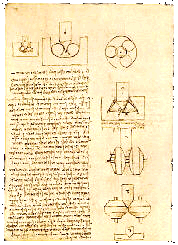| HISTORY OF SCIENCE FRICTION |
|
Leonardo Da Vinci (1452-1519) was one of the first scholars to study friction systematically. He realized how important friction is for the workings of machines. He focused on all kinds of friction and drew a distinction between sliding and rolling friction.
The sketches represents four types of antifriction bearings. The conical- shaped pivot of a rotating vertical shaft meets with greater or less resistance when resting on: (a) three ball-bearings,
Note that the first statement is counterintuitive; most of us would assume that friction does depend upon the cross-sectional area.
Leonardo made the observation that different materials move with different ease. He surmised that this was a result of the roughness of the material in question; thus, smoother materials will have smaller frictions. Leonardo Da Vinci did not publish his theories, so he never got credit for his ideas. The only evidence of their existence is in his vast collection of journals. Guillaume Amontons (1663-1705) rediscovered the two basic laws of friction that had been discovered by Leonardo Da Vinci, and he also came up with an original set of theories. He believed that friction was predominately a result of the work done to lift one surface over the roughness of the other, or from the deforming or the wearing of the other surface. For several centuries after Amontons' work, scientists believed that friction was due to the roughness on the surfaces. Charles August Coulomb (1736-1806) adds to the second law of friction; "strength due to friction is proportional to compressive force", "although for large bodies friction does not follow exactly this law". Coulomb published the work referring to Amontons. The second law of friction is known as the "Amontons-Coulomb Law" referring to work done by the two scientists in 1699 and 1785 respectively. The Amontons-Coulomb law of friction holds for many different material combinations and geometries but unlike Newton’s first law, nothing fundamental can be derived from it. F. Philip Bowden and David Tabor (1950) gave a physical explanation for the laws of friction. They determined that the true area of contact is a very small percentage of the apparent contact area. The true contact area is formed by the asperities. As the normal force increases, more asperities come into contact and the average area of each asperity contact grows. The frictional force was shown to be dependent on the true contact area—a much more intuitively satisfying argument than what the Amontons-Coulomb law allows. Bowden and Tabor argued that within these asperities all of the dynamics of friction take place. The friction hypothesis from dragging one surface up the roughness of the other surface is dismissed. Adhesion was up till now dismissed because for it true friction would have to be proportional to the cross-sectional area. Further study is concentrated on micro scale contacts formed between single and multiple asperities with deformation and adhesion considered. The invention of the atomic force microscope (AFM) in 1986 enabled scientists to study friction at atomic scale. With the basic mechanisms of friction at atomic scale understood it must be studied how these mechanisms change with the contact area at macroscopic scale. Animation of single
asperity contact, Finite Element Modelling (265kb)>> |
| www.tribology-abc.com |

 Leonardo
stated the two basic laws of friction 200 years before
Newton even defined what force is. Da Vinci simply stated that:
Leonardo
stated the two basic laws of friction 200 years before
Newton even defined what force is. Da Vinci simply stated that: